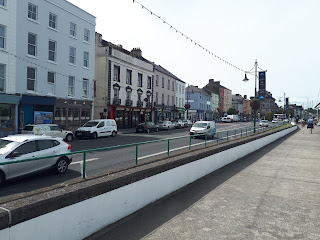The morning routine for our bus tour of Ireland is:
-
Get up early enough to repack the suitcase and set it
outside your door by 6:45 am, so the staff can load it onto the bus
while we have breakfast.
-
Breakfast starts at 7:00 am
-
Bus leaves at 8:00 am
Our first stop was Gleann dá Loch, “Valley between two lakes,” a national park siting an ancient abbey community. The visitor’s centre had a model of what the community looked like at its height, with inner and outer enclosure walls, farmland, and orchards, but I didn’t think to take a picture. Here is the gateway to the settlement, which, if I recall correctly, was built much later than the settlement itself.
The Round Tower, a former bell tower, used to have six floors, each reached by ladder from the lower. The main entrance was about three metres up, reached originally by a rope ladder that could be pulled up in the event of attack.
St. Kevin’s Church is intact, unlike the cathedral, of which I didn’t get a good picture.
One of many Celtic crosses we saw. We were told it combined the Christian cross with the earlier pagan sun symbol.
Inside the ruined cathedral were some headstones, probably brought inside to protect them from the elements. One had dates that claimed the deceased was over 100 years old, but the guide said that most likely a son who had the same name (which wasn’t unusual) took on his father’s birth date to keep the land in the family; at that time, on the death of the landowner, the land would revert to the British. It was a way for the Irish to preserve their property for a while – until, I suspect, the British caught on that some Irishmen seemed to be living much longer than the average 35 years.
A view of St. Kevin’s Church and the Round Tower from the exit.
We had lunch in the small town of Clonroche. We then continued south into Waterford County and the town of Waterford, which was originally a viking settlement called Vadrarfjordr: “Weather harbour” The ancient city was built where two rivers joined, and surrounded by a wall.
Waterfront scenes
The Medieval Museum, behind a medieval wall.
We toured the Waterford Crystal factory – a recent building, much smaller than the original huge factory that we passed on the way out of town.
They showed us the four main crafts, each of which takes eight years to master; people usually learn only one, but there was one whose name I neglected to write down who was a master at all four. We saw people actively working at glassblowing and cutting, and at the end were shown the “spares” of several one-off pieces used for commemorations and trophies.
We noticed or were told about several other things along the way.
-
There are a lot of roundabouts (traffic circles) at highway
intersections; in County Wexford we traversed a pair that could only
have been a few dozen metres apart.
-
There is apparently a tax on vehicles whose proceeds go to
supporting “road art. One of the ones we passed was the statue of
a stag.
-
We saw speed radar that in addition to your actual speed
(in red or green, depending on whether you were over or under the
limit), also displayed “thank you” in green when you were under
the limit, and a frowny face in red when you were over.
-
We passed a Traveller encampment. The driver said the
government has been building permanent homes, with the deal that if
you live in one, your children have to go to school.











No comments:
Post a Comment